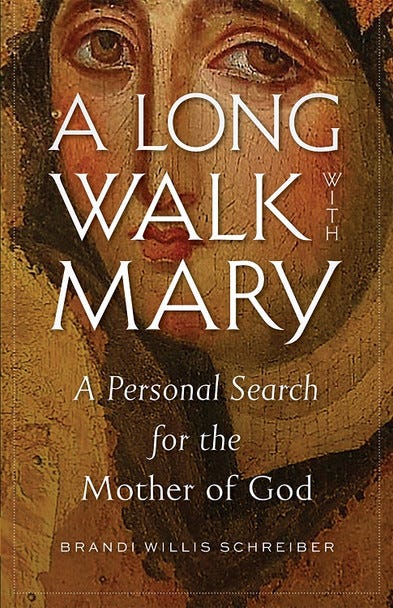
Diakonissa
is a wife, mother, West Texas native and resident, and published author of poetry, nonfiction, and award-winning fiction. She is also the author of A Long Walk with Mary: A Personal Search for the Mother of God, a deeply personal but beautifully universal memoir in which she relates her own quest to know and love the Virgin Mary and to incorporate her as a vital participant in her spiritual life. Brandi's sparkling, vulnerable account invites the reader to join her in this quest.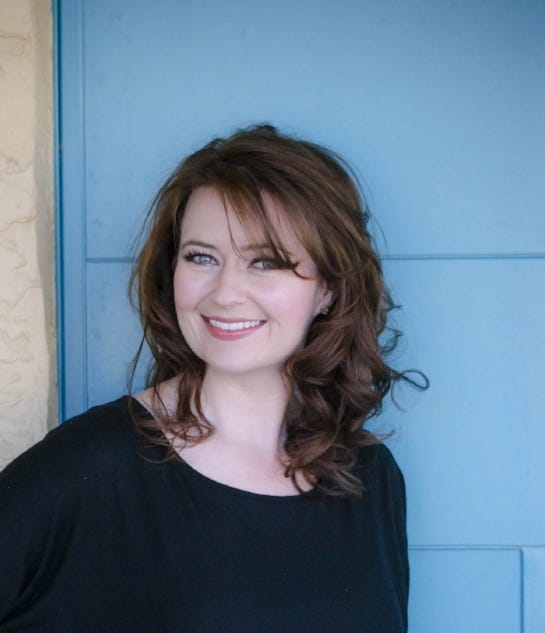
“Sparkling” and “vulnerable” are also words that came to mind for me while interviewing this amazing woman, as well as encouraging, honest, gracious, kind, and personal. It was a true joy, and humbling, to speak with her, and I pray this interview blesses you as much as it did me.
At the bottom of this transcript, you can find a resource list of everything that Brandi mentioned during our talk.
Most Holy Theotokos, save us!
Catie: I’m really excited to be here with Brandi Willis Schreiber! She’s the author of A Long Walk With Mary: A Personal Search for the Mother of God, which was published by Ancient Faith in 2021. This was a book that was really impactful for me personally because at the time during the pandemic, I was soul-searching and trying to draw closer to the Theotokos in my own life. So having this book come out and be so beautifully written and personal was a huge blessing for me personally and I’m sure many other people. Brandi, do you want to talk a little bit about your book and the work you do as an author?
Brandi: Sure! First of all Catie thank you so much for having me here. We were having a good conversation about God’s providence before we hit the record button. I’m really grateful and so touched to be on your amazing podcast and on the Substack that you’re writing. I read through some of your posts and they are so beautifully and thoughtfully done. And they’re good, long pieces! So I appreciate so much that you invited me to be on your Substack and talk about this.
I live in West Texas and am trying to be an author full time, but that doesn’t pay bills! My background is in poetry and writing, and I’ve been doing it almost all my life. I wrote A Long Walk With Mary: A Personal Search for the Mother of God at a time when I had been Orthodox for over a decade, and I was really going through a tough personal time. It seemed to be culminating in this reality that I needed to get to know her better. I had really been avoiding that for a good ten years, for a lot of different reasons, some of which I can name and some of which were probably unconscious. I came to the conclusion I needed to seriously spend some time exploring her, learning about her, and trying not to be so afraid of what might be revealed to me as I got to know her.
Through that process I took a lot of walks—I love being out in nature—I prayed, journaled, wrote, read, researched, and wrestled with God, so to say. I asked a lot of my questions out loud and privately in the night sky. That book is the result of about a year and a half of praying and asking a lot of really deep, difficult questions, and asking her to help me and reveal herself to me, and trying to understand what it all meant.
I’m so grateful for it, because I was looking for resources, specifically for folks who had grown up Protestant and had converted to Orthodoxy, who were not necessarily struggling with the Theotokos, because I didn’t struggle with her, but I really didn’t understand who she was and what she was about, on an intimate level. I couldn’t find anything. You mentioned before we started recording that there are a lot of resources I included in the book, and I read everything I could about the Theotokos from an Orthodox perspective, but I couldn’t find anything for someone like me.
So I thought, I want to be able to share this journey and write about what it means to get to know her, particularly as a convert, and share that with other people. The book was really the result of that. I’m so grateful to Ancient Faith, because they embraced the project and took it on, and were wonderful to work with. It was definitely an answer to many prayers. It’s still a prayer that I’m praying—it never goes away, endeavoring to understand these things. So that’s a little bit about me.
I’m at home with my little boy right now. My husband, David, is a deacon in our Orthodox church here. He’s also a Crimes Against Children detective, so, let your imagination go to the worst places it possibly can about the stuff that happens to babies and kids, and what he does for a living is investigate those things. I’m very proud of him for the work that he does.
I still write a bit on the side—I have a Substack, too, so we’ll have to share each other’s pages! My Substack focuses on some longer contemplative essays, and I also do a devotional for paid subscribers. In between that, I’m still trying to figure out what my next big project is going to be. It’s going to reveal itself, as it always does—it’s probably going to involve something with my life at home with my little boy. So that’s a little bit about me and where I’m at!
Catie: Awesome, thank you so much! I’m definitely excited to keep up with your updates and hear about whatever God has in store for you for that next book.
So, in your lovely book, I really like how towards the beginning you go back to the Gospel according to Matthew, where Christ assures us that whatever we ask, we shall receive, seek, and you shall find, knock, and the door shall be opened to you, and how you connected that to your earnest and sincere search to get to know Mary.
As you were asking God for help with this and asking Mary to reveal herself, what did you experience about God and His love for us, or about Mary and her love for us?
Brandi: That’s a great question, and it’s a big question because it has an endless well of answers. I learned first of all—I’ve always known this, but I didn’t really know it, that God is love. His abundance of love for us has no limit or end. So that verse from the Gospel is really about if you’re seeking and asking and wanting to find, if it’s within God’s will, which is ultimately for love, you’re going to get an abundance of an answer in return.
If you’re seeking and asking and wanting to find, if it’s within God’s will, which is ultimately for love, you’re going to get an abundance of an answer in return.
The receiving of that gift sometimes is a little tough. So what I learned in that process is that that’s where grace comes in. Grace is such a lovely, misunderstood concept in Christianity. The aspect of grace is that you will be given the strength, the gift, the ability, the joy, because of what God has given to you. It’s not on your own understanding, your own control, your own will. That’s what I really had to learn in that process: I’m not controlling this outcome. God and Mary are revealing beautiful things to me about who Mary is—the traditions, the history, the value and relevance surrounding her—which are very small words, by the way, to describe the Mother of God. I was getting such a huge abundance of this that it was almost overwhelming.
It really helped define my place within the faith and within my life, because in a lot of ways I was struggling with that too. We’ll come to that question in a second, as it relates to femaleness: what does it mean to understand, to revere, to venerate the Mother of God? What it means is that it completely transforms our understanding of Christ and who He is.
What does it mean to understand, to revere, to venerate the Mother of God? It completely transforms our understanding of Christ. To dive deeper and understand the iconography better, and the deep history and tradition of the Church surrounding our love for her—that helped me to love, and to feel a little bit more vulnerable and safe, with Christ as well.
What I talk about in the book is that our love and veneration for Mary are always Christological. She is always pointing the way to Christ: in her iconography, in the traditions and theology we have about her. It’s not just about her! She’s always teaching us, literally and figuratively pointing the way to Christ, through her actions and her words but also in her iconography.
I knew that as an Orthodox Christian, but to dive deeper and understand the iconography better, and the deep history and tradition of the Church surrounding our love for her—that helped me to love, and to feel a little bit more vulnerable and safe, with Christ as well. As I was understanding her, I was understanding my faith better: the Holy Trinity, what it means to be a Christian.
I think that’s one of the things that’s a little bit tragic about growing up Protestant—the complete divorce and separation from that. You realize you’re very small in it, but God is there to help guide you, to give you the answers you’re seeking. He’s going to do it. Sometimes it’s going to hurt and you’re going to face yourself in that process, questions about yourself and your own realities. But that ultimately is a good thing. It’s supposed to be a dynamic relationship and experience that we have as Christians, not a stagnant one.
Catie: I never would have thought how deeply it would transform how we understand and experience Christ, but that makes complete sense. Thank you for sharing that.
Moving on through the book, I was really struck by your observations of how in Orthodoxy, the faith has a more communal emphasis, not individualistic. You write that “we’re saved together, not alone.” And that makes us more humble. One thing you talked about, that contributes to that fuller and richer understanding, is getting to know the Saints who have gone before us—so many holy people whom we are in communion with, whom we can pray to and look up to. I’d love it if you could expand on that.
Brandi: Absolutely. First of all, the idea of “cultivating communion with the saints” comes from Fr. Thomas Hopko of blessed memory. If you’re not familiar with his Maxims on the Christian Life, I would definitely recommend Googling it. It’s a lovely list of 55 pieces of advice that he gives to people about how to live the Christian life. It is the simplest and most beautiful, but the most incredibly difficult and challenging list in its simplicity, because he is speaking to human beings, living and working as Christians. Each of the items on the list, by itself, seems so simple, but is the work of an entire lifetime. “Cultivate communion with the saints” is his 17th Maxim.
As I was learning about Mary, I could not help but learn about and better understand our relationship with all the saints. It is a cloud of witnesses, a living, (so to speak) breathing reality, which is not separate from us. That is such a gift in Orthodoxy—not to be separated from the people who have gone before, who serve as examples and guides for how we can live our life and ultimately pursue Christ and theosis, which is ideally the goal of every Christian, although it’s going to take our entire lives, and then some, to get there. You can’t separate those two. So it was a natural reality that as I was learning about Mary and her place within our faith tradition, it was going to pull all of these other people into that, who are a part of our tradition and have lived this life for Christ.
The saints are a cloud of witnesses, a living, (so to speak) breathing reality, which is not separate from us. It’s such a gift in Orthodoxy not to be separated from the people who have gone before, who serve as examples and guides for how we can pursue Christ and theosis, which is ideally the goal of every Christian.
The interesting thing about Fr. Thomas’s list is that right after #17, “Cultivate communion with the saints,” is #18, “Be an ordinary person, one of the human race.” I love that that follows, because the reality is that the saints were ordinary people—until they weren’t. We are ordinary people—until we aren’t. Pursuing Christ is what makes us different, extraordinary. We do that until the very end. That piece alone was what really bolstered my faith and gave me more hope and inspiration and feeling that I wasn’t alone in this.
I took a lot of late night/early morning walks where I cried, prayed and just struggled. Like we all do, I struggled with questions, what was going on in my life and what I was supposed to do next, just basically asking for help. A lot of times, I got an answer to those questions, those tears and struggles. Sometimes, I felt like they came from the Theotokos, and sometimes from something much greater and bigger. That’s the beauty of Orthodoxy—we get to embrace that. That gets to be a part of our daily experience. It doesn’t just happen on special feast days—it’s a daily occurrence. That distance from those we love and learn from is much more shortened. I think that can be incredibly helpful for someone, to think about cultivating communion with the saints, as you’re struggling through whatever life may be bringing you.
Catie: I love the 55 Maxims, but somehow I never made that connection between being ordinary and cultivating communion with the saints. Like you said, the saints are ordinary people like us so we can relate to them, but they’re also extraordinary and show us how to grow into that theosis and become one with God.
As you mentioned in response to the first question, you had this phrase in the book about “female spiritual closeness” and how drawing closer to the Theotokos was one of your first experiences of that. I would love to hear a bit about what she has shown you about what it means to be a faithful and holy Christian woman.
Brandi: I think she, and Orthodoxy in general, really opened the door to answering that question for me. If you don’t understand the value and the holiness of the Theotokos, which includes her femaleness, then you can’t possibly understand the value and holiness of any other exemplary female saint from the Bible, from our tradition and history. It all begins with the female person whom God chose to be His mother.
I want to put a disclaimer here, because I know you may have readers and listeners from all different backgrounds. I am not in any way disparaging my Protestant roots. I grew up Church of Christ, and I’m very grateful for those roots, because it had a lovely foundation that led me to Orthodoxy. So I never want to speak disparagingly about the faith in which I grew up.
But! There was absolutely no love at all for Mary. She was something on a picture card, she showed up at Christmas, she had other children—which is absolutely not what the Orthodox believe. I didn’t have any exposure whatsoever to her value, or to the value of many, I’m going to say, “female characters” from the Bible—forgive me for using that word; I’m coming back to my roots! You had to use your brain to figure it all out. You had to rationally look at each person in the Bible, see what he or she had to offer in terms of your Christian journey and relationship with Jesus. That is not the Orthodox approach at all.
When you understand the fullness of Mary, who she was and why she was so important, her “yes” to God, her virtue, her ever-virginity and why she chose that, her willingness and her own choice to pursue this path that God placed before her—that helps us understand who we are as females. That’s wonderfully freeing, because it means that you can rest in the reality that being female is just as valuable and important as being male.
When you understand the fullness of Mary, who she was and why she was so important, her “yes” to God, her virtue, her ever-virginity and why she chose that, her willingness and her own choice to pursue this path that God placed before her—that helps us understand who we are as females.
I felt like growing up, I didn’t really have a lot of female heroines. There weren’t a lot of heroines that I heard or read about when it came to Bible school. You’ve got your key players, of course, but Mary is the one whom God chose for many different reasons. So she ends up being our ultimate model. All of the virtues she possessed are things we can endeavor to emulate.
When you go into an Orthodox church and you’re looking at the iconostasis and see that Christ is on one side and the Theotokos is on the other—the first time I walked into an Orthodox church and saw that, I was like, “Whoa! This is a little too equal.” But then you start to understand the theology behind that and you realize this is a wholeness of being, of humanity, of purpose. Christ is fully God and fully human—and it’s Mary who provided that humanity. If Mary is the one who provides that humanity, what example is that in my life, since I’m human? What can I see when I look to her?
Catie: I think maybe that’s also connected to why, during the pandemic, I was trying to learn more about the Theotokos. It seems like in our culture, even today, we don’t have a lot of female role models who are not trying to be stereotypically masculine. So this is really cool to realize that in our own tradition, the Theotokos is that—she shows us how to be a woman and just rest in who God created her to be, without trying to be something she’s not.
Brandi: Exactly. That means, too, that whenever we read about the lives of other female saints, we see that they come from a myriad of radically different backgrounds. We look at St. Mary of Egypt, just as one example—the Theotokos completely transformed her life! We can rest in that—we don’t have to pursue being something different or other than what we are, except for what we need to change about ourselves to grow closer to Christ. I don’t have to be other than who I am. I get to be who I am, but I can find my way within that by looking at the Theotokos, and other female saints, as my examples. To me, that was wonderfully freeing, because I didn’t have to figure it all out in my head. I already had the blueprint for that. It was like, maybe I just get to figure out who I am, instead of constantly trying to be something different.
Catie: Great point about how we really have all types of female saints in the Orthodox tradition. Another favorite book of mine is The Ethics of Beauty—the author, Timothy Patitsas, has a chapter in there where he explains what he sees might be a potential Orthodox gender theology—how do men become holy, how do women become holy, is it different, what are the differences? He talks about the “gender chiasm,” where in all the hymnography for female saints, including the Theotokos, they’re praised for being “strong,” “protectors,” “guardians”—things that you would not associate in our world with femininity, but with masculinity. And the opposite for men, who are praised for being “meek,” “gentle,” “loving.”
So back to your book, drawing a connection to what we were just talking about, the Theotokos was very courageous. She said “yes” at the risk of her reputation, even her life—Joseph wanted to put her away quietly—but she had courage and faith in God. You were connecting that to other times when God has been inviting you to say “yes” to things that were scary. You had this beautiful line about having “faith in what may be instead of fear of what may be.” All that to say, if you were giving advice to a younger Orthodox woman or just a younger woman interested in Orthodoxy, what advice would you have for having that courage and faith in God to say “yes” when it’s scary?
Brandi: That’s a great question. I really want to read The Ethics of Beauty! I have not taken the dive and purchased it yet, but that chapter sounds amazing. Thank you so much for illuminating that for us. I think females don’t often get credit for being courageous, but that is another thing that is so lovely about Orthodoxy—this beautiful weaving and cross-praising like you were talking about in that chapter. I think people really don’t understand how revolutionary that is, because we don’t normally think in terms of that. There are all kinds of those dichotomies and paradoxes that constantly appear in our hymnography and in the services of the Church. I just love it! Every time I come across one of those pieces of writing, I’m like, “Yes!” Look at, not how innovative—because we don’t necessarily want to be innovative—but it’s this lovely exploration of characteristics and traits that are given to saints through their hymnography and the writings of the Church. So thank you for bringing that up!
I had to think really carefully about this question. I realized that the answer I’m coming up with is probably more for myself. I hope it will help other young women, and I love the focus of your Substack and this question in particular. I came up with three things that I hope might help for practicing courageous faith. The first one seems to be the most obvious, but for me it’s also the most challenging, and that’s to pray. It is the foundation of everything we do, in our public and private life, our public and private worship. It’s about that communication and relationship we are building. Pray about who you are, what you’re doing, what you think you’re called to do, what God wills you to do.
Pray about who you are, what you’re doing, what you think you’re called to do, what God wills you to do.
My favorite books on prayer, and I included them in the resource section in the back of A Long Walk With Mary, are Metropolitan Anthony’s two books on prayer, Beginning to Pray and Courage to Pray. I love his no-nonsense, linguistic approach to describing prayer. I just devoured those books in one sitting. I highlighted them, reread them a dozen times, and I still feel like I could go back into them at least twenty more times and get something out of them. And then, although it comes from a contemplative prayer background, anything by Martin Laird. A Sunlit Absence and An Ocean of Light were two smallish books on contemplative prayer that I really loved. I think it’s quite harmonious with the Orthodox approach of praying and experiencing deep prayer within the nous. I love his books—they have beautiful descriptions and words, which really appeals to me. So I would say first of all, you’ve got to start with prayer.
The second thing might seem a little bit unusual, but it’s to embrace doubt in the process of whatever you’re dealing with as you’re learning to have courageous faith. This has been attributed to lots of different writers: “Faith is not the absence of doubt.” These two things, in my experience and belief, coexist. There are always going to be moments of doubt. I’m constantly experiencing moments where I’m like, “is this real? Is this true? Am I right and correct, or delusional?” I don’t think faith is saying that you’ve got it all figured out rationally, you ticked it all off in your head, you know what’s going on, and now you just have to have faith to move forward, and that’s it—you figured it out, came to the right conclusion and answer, so now you can move forward without any struggle. That’s not life, and it’s certainly not in the Gospels, not what Christ taught.
One of my favorite arrow prayers is “Lord, I believe; help my unbelief.” If you’re not familiar with that story, in Mark 9:24, what happens is Christ has just been transfigured on Mount Tabor. The glory of God has been revealed to a few key people. He comes down from this amazing thing that has just occurred, to a crowd. In the crowd, this father is crying out to Christ, telling Him about his son, who is “consumed by a mute spirit,” according to the New King James Version. The situation in which the son is suffering is told three times. First, the father tells it to Christ and describes these horrible things his son is enduring—foaming at the mouth, becoming rigid, clearly physically suffering. Then the crowd witnesses it when Christ speaks to him. Then, the father explains it again after Christ asks him how long this has been happening. He says it’s been happening since childhood, and tells another bit of detail about the things the son suffers from. So there are three instances where Mark describes the physical suffering of this child, and you also see the physical suffering of the father. The father says to Christ, “If you think you can do something, we’ll take it.” I’m paraphrasing here. And Christ says to him, “If you can believe, all things are possible to him who believes.” When I read that, I feel like it’s a little bit of a challenge, an ultimatum. It’s like he’s saying an “if-then” to him—“if you believe, then it’ll happen.” How many of us struggle with, “if I could just believe, if I could just trust, if I could just move forward in faith without any of this struggle or suffering or doubt?” But the father says what I think is one of the best “crowd lines” in the New Testament, “Lord, I believe; help my unbelief.” He cries this out with tears in his eyes. And Christ heals the boy.
So when you start to struggle with your courageous faith, and start to say to yourself, “I’m not courageous, I can’t do this, I’m moving forward in weakness, tears, struggle, and darkness. I don’t even know if I can move forward,” if you can just remember to pray, “Lord, I believe; help my unbelief,” you will be helped. That has been my experience and I really believe that.
My third tip for trying to live courageous faith is to ask for help as you endure your cross, whatever that may be. Thankfully, we have the ability to ask lots of people for help—God the Father, Christ, the Holy Spirit, our guardian angel, our patron saint if you have one, the saints of the Church, the Theotokos—we have all of them to help, plus the people around us, guiding and loving us on our way.
I wanted to show you this icon and I’ll describe it to you. It is the icon of the crucified monk. If you Google “icon of crucified monk” or “icon of crucified nun,” you will find this beautiful and very interesting contemplative image of a monk or nun being crucified. Around the monk or nun are often depicted little demons shooting arrows, and each of them have a particular vice, like envy, gluttony, avarice, anger, lust, pride, and despair on my particular icon. My priest told me about this icon when I was going through my hard time. A lot of our conversations were centered around how you carry your cross, because that is what Christ calls us to do—to pick it up, trudge along, ask for help and grace and mercy to endure whatever our cross is. This icon has been extremely helpful to me, because when I start to despair about anything, or I struggle with one of those passions, or I just struggle with life—what does it mean, who am I, what am I supposed to do, all those things—remembering that there is iconography in the Church that can help us place ourselves in that space was incredibly comforting.
So that might be something too, as you’re asking for help as you endure the cross of your life, to surround yourself not only with prayers and petitions, but also with visual images that can help lift you up and support you. You don’t have to spend money on them—you can Google and print out and cheaply laminate whatever you can find, which is very cost-effective. So those are my three tips for practicing courageous faith.
Catie: Thank you! Yes, all three of those are so powerful. I’d like to get my own copy of that icon—it’s incredible.
My final question has to do with when you talked in the book about going through pregnancy and birth, and how you drew closer to Mary during those very special and unique times. Now that a few years have gone by, I wanted to ask how you have continued to draw closer to the Theotokos in your motherhood?
Brandi: I definitely ask her for a lot of help! I find myself contemplating the few lines that she speaks that have been recorded in the Bible, as well as what it must have been like for her at each of the stages of Christ’s life and upbringing. You don’t have to be a mother for that to have relevance. There are reasons why those few, particular lines were recorded, why we don’t have long swaths of dialogue. She was a poet—her Magnificat, her praise for bearing Christ and greeting her reality, the “yes” that she said, that’s a poem, so we have her poetry to guide us. I pray to her a lot and ask for the virtue that she must have possessed to have been a good mother. Not only was she chosen to be the Mother of Christ, but she had to have been a good mother, because we get lots of glimpses of that in the Gospels. It’s a richer, more wholesome experience being a mom and being able to continue on this journey with her, praying to her, asking for her intercessions and help, and understanding how hard it is to be a parent.
But it doesn’t matter, like I said, if you have a child or not. Growing closer to Mary helps you be a better “mother” to everybody. It helps you to be a better daughter, a better friend, a better coworker. You don’t have to pursue the life of motherhood to reap the benefits of what she teaches us and what that close relationship can do for you. We’re all called to different roads and purposes in life, and motherhood might not be something that every female pursues for different reasons. So that’s been great too, because now I’m like, “okay, I’m always going to be a mom, but how is this going to play into my life outside of being a mom?” How does it play into me just being me? What does she teach me about being me? That goes back to what we were talking about earlier, about resting in who we are, not being afraid to face ourselves and say, “I’m Brandi, this is who I am, this is how God made me. These are the things He’s put on my heart, this is how I want to be. Help me with those things.”
It’s a richer, more wholesome experience being a mom and being able to continue on this journey with her, praying to her, asking for her intercessions and help. But it doesn’t matter if you have a child or not. Growing closer to Mary helps you be a better mother to everybody.
Catie: Thank you! I feel like in your answers, you have this freedom. That resonates with me, as I’ve been continuing to learn what it means from the Orthodox perspective to be a woman, there’s so much freedom. There is something the Church can tell us about what it means to be a woman, but it’s really about who did God make me to be? Whether or not He called me to motherhood, He has a plan and a path for me.
This has been so inspiring, and I know that people are really going to enjoy this interview. Do you have any final thoughts before we say goodbye for today?
Brandi: I don’t think so, but I just want to say thank you again for the opportunity to be here, and I’m so excited that we can stay connected and keep up with each other. I’m so grateful to have the opportunity to visit with you Catie, and learn more about you and be a resource to you and hopefully to others, and you the same to me.
Catie: Glory to God! Thank you so much, Brandi, I really appreciate it!
Brandi: You’re welcome!
Thank you so much for reading or listening to our conversation! We’d love to hear in the comments what stood out to you!
For your convenience, here is a list of all the resources Brandi mentioned during our talk:
A Long Walk With Mary: A Personal Search for the Mother of God (Brandi’s book published by Ancient Faith)
Writing from the Desert Places (Brandi’s Substack)
Beginning to Pray by Metropolitan Anthony
Courage to Pray by Metropolitan Anthony
A Sunlit Absence by Martin Laird
An Ocean of Light by Martin Laird
Icon of the Crucified Nun (or Monk)
Stay tuned for “Acquire the Holy Spirit,” which is Chapter 5 of You Shall Be Holy: Reflections on Orthodox Womanhood, coming soon!


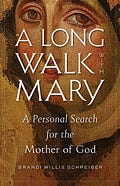



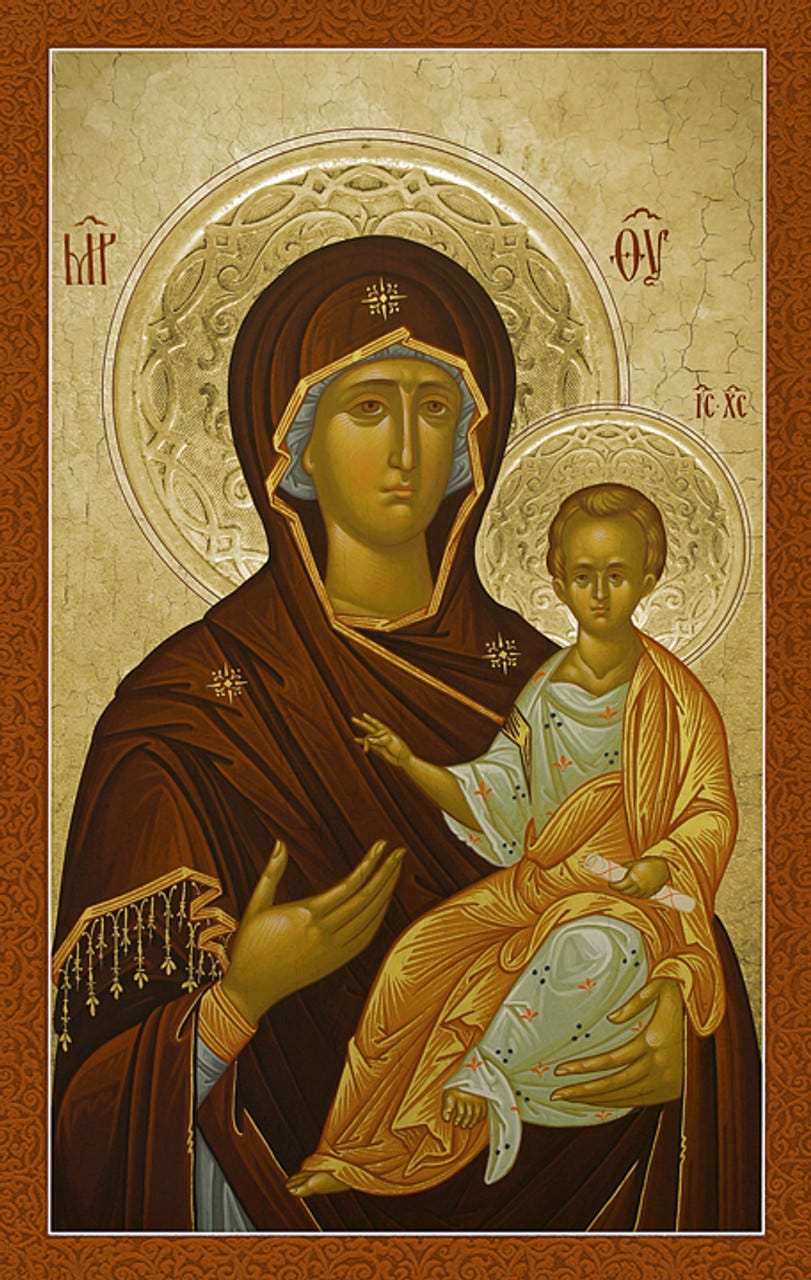
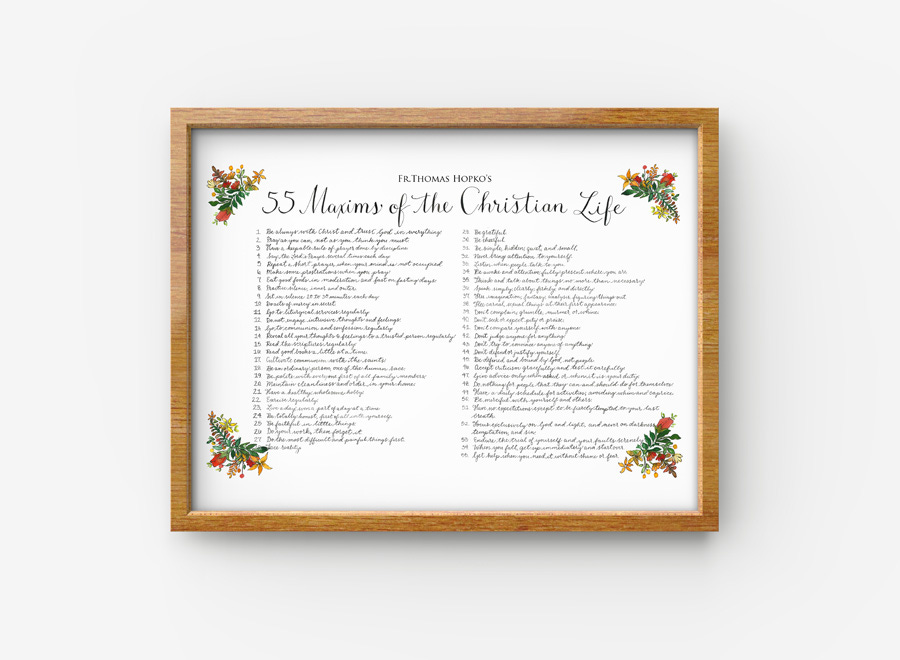
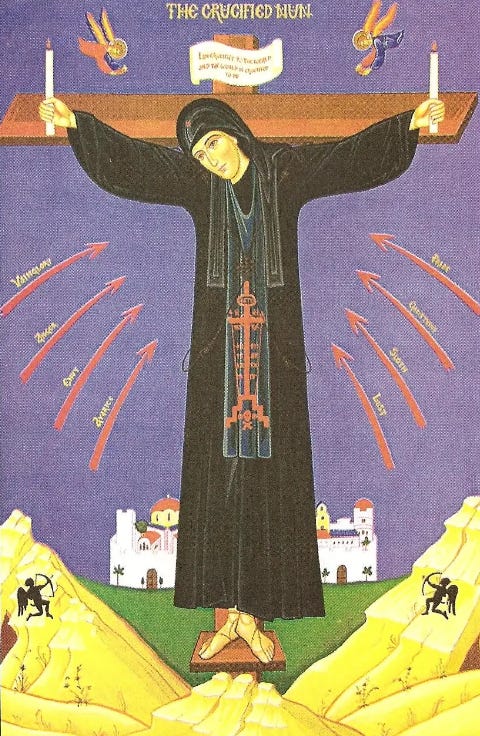


How and Why to Love the Mother of God